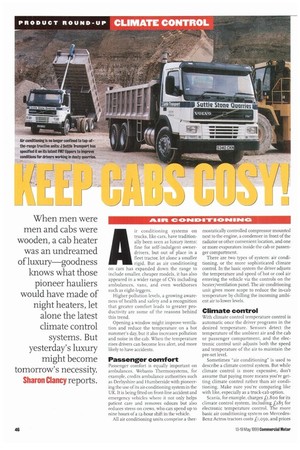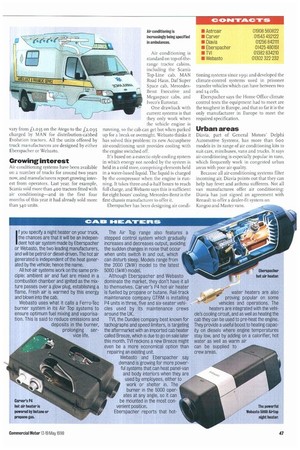When men were men and cabs were wooden, a cab
Page 48

Page 49

If you've noticed an error in this article please click here to report it so we can fix it.
heater was an undreamed of luxury—goodness knows what those pioneer hauliers would have made of night heaters, let alone the latest climate control systems. But yesterday's luxury might become tomorrow's necessity. Sharon Clancy reports. AMPS 4M40■1141EIONTE413141dOPIICit Air conditioning systems on trucks, like cars, have traditionally been seen as luxury items: fine for self-indulgent ownerdrivers, but out of place in a fleet tractor, let alone a smaller rigid. But as air conditioning on cars has expanded down the range to include smaller, cheaper models, it has also appeared in a wider range of CVs including ambulances, vans, and even workhorses such as eight-leggers.
Higher pollution levels, a growing awareness of health and safety and a recognition that greater comfort leads to greater productivity are some of the reasons behind this trend.
Opening a window might improve ventilation and reduce the temperature on a hot summer's day, but it also increases pollution and noise in the cab. When the temperature rises drivers can become less alert, and more likely to have accidents.
Passenger comfort
Passenger comrort is equally important on ambulances. Webasto Thermosystems, for example, credits ambulance authorities such as Derbyshire and Humberside with pioneering the use of its air-conditioning system in the UK. It is being fitted on front-line accident and emergency vehicles where it not only helps patient care and removes odours but also reduces stress on crews, who can spend up to nine hours of a tz-hour shift in the vehicle.
All air conditioning units comprise a then rnostatically controlled compressor mounted next to the engine, a condenser in front of the radiator or other convenient location, and one or more evaporators inside the cab or passenger compartment.
There are two types of system: air conditioning, or the more sophisticated climate control. In the basic system the driver adjusts the temperature and speed of hot or cool air entering the vehicle via the controls on the heater/ventilation panel. The air conditioning unit gives more scope to reduce the in-cab temperature by chilling the incoming ambient air to lower levels.
Climate control
With climate control temperature control is automatic once the driver programs in the desired temperature. Sensors detect the temperature of the ambient air and the cab or passenger compartment, and the electronic control unit adjusts both the speed and temperature of the air to maintain the pre-set level.
Sometimes "air conditioning" is used to describe a climate control system. But while climate control is more expensive, don't assume that paying more means you're getting climate control rather than air conditioning. Make sure you're comparing like with like, especially as a truck-cab option.
Scania, for example, charges fr,800 for its climate control system, including £285 for electronic temperature control. The more basic air conditioning system on MercedesBenz Actros tractors costs fr,o 5°, and prices
vary from £1,035 on the Atego to the £2095 charged by MAN For distribution.cabbed Evolution tractors. All the units offered by truck manufacturers are designed by either Eberspacher or Webasto.
Crowing interest
Air conditioning systems have been available on a number of trucks for around two years now, and manufacturers report growing interest from operators. Last year, for example, Scania sold more than 400 tractors fitted with air conditioning—and in the first four months of this year it had already sold more than 340 units.
Air conditioning is standard on top-of-therange tractor cabins, including the Scania Top-Line cab, MAN Road Haus, Daf Super Space cab, MercedesBenz Executive and Megaspace cabs, and Iveco's Eurostar.
One drawback with current systems is that they only work when the vehicle engine is running, so the cab can get hot when parked up for a break or overnight. Webasto thinks it has solved this problem: its new Accusphere air-conditioning unit provides cooling with the engine switched off.
It's based on a eutectic-style cooling system in which energy not needed by the system is held in a cold store, comprising elements held in a water-based liquid. The liquid is charged by the compressor when the engine is running. It takes three.and.a.half hours to reach full charge, and Webasto says this is sufficient for eight hours' cooling. Mercedes-Benz is the first chassis manufacturer to offer it.
Eberspacher has been designing air condi honing systems since 1991 and developed the climate-control systems used in prisoner transfer vehicles which can have between two and 14 cells.
Eberspacher says the Home Office climate control tests the equipment had to meet are the toughest in Europe, and that so far it is the only manufacturer in Europe to meet the required specification.
Urban areas
Diavia, part of General Motors' Delphi Automotive Systems, has more than 600 models in its range of air conditioning kits to suit cars, minibuses, vans and trucks. It says air-conditioning is especially popular in vans, which frequently work in congested urban areas with poor air quality.
Because all air-conditioning systems filter incoming air, Diavia points out that they can help hay fever and asthma sufferers. Not all van manufactures offer air conditioning: Diavia has just signed an agreement with Renault to offer a dealer-fit system on
Kangoo and Master vans.
410 41:35 PI TALC TIES
• Astroair 01908 560822 • Carver 01543 452122 • Diavia 01256 842111 • Eberspacher 01425 480151 • TVI 01382 834210 • Webasto 01302 322 232
If you specify a night heater on your truck, the chances are that it will be an independent hot-air system made by Eberspacher or Webasto, the two leading manufacturers, and will be petrol or diesel-driven. The hot air generated is independent of the heat generated by the vehicle; hence the name.
All hot-air systems work on the same principle: ambient air and fuel are mixed in a combustion chamber and ignited as the mixture passes over a glow plug, establishing a flame. Fresh air is warmed by this energy and blown into the cab.
Webasto uses what it calls a Ferro-Tec burner system in its Air Top systems to ensure optimum fuel mixing and vaporisation. This is said to reduce emissions and deposits in the burner, prolonging service life.
The Air Top range also features a stepped control system which gradually increases and decreases output, avoiding the sudden changes in noise that occur when units switch in and out, which can disturb sleep. Models range from the 2000 (2kW) model to the latest 5000 (5kW) model.
Although Eberspacher and Webasto dominate the market, they don't have it all to themselves. Carver's P4 not-air heater is fuelled by propane or butane. Rail-track maintenance company GTRM is installing P4 units in three, five and six-seater vehicles used by its maintenance crews around the UK.
TVI, the Dundee company best known for tachographs and speed limiters, is targeting the afterrnarket with an imported cab heater called Breeze, which is due to go on sale later this month. TVI reckons a new Breeze might even be a more economical option than repairing an existing unit.
Webasto and Eberspacher say demand is growing for more powerful systems that can heat panel-van and body interiors when they are used by employees, either to work or shelter in. The burner in the 5000 operates at any angle, so it can be mounted in the most convenient position.
Eberspacher reports that hot water heaters are also proving popular on some vehicles and operations. The heaters are integrated with the vehicle's cooling circuit, and as well as heating the cab they can be used to pre-heat the engine. They provide a useful boost to heating capacity on diesels where engine temperatures stay low, and by adding on a calorifier, hot water as well as warm air can be supplied to crew areas.
















































































































